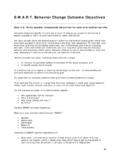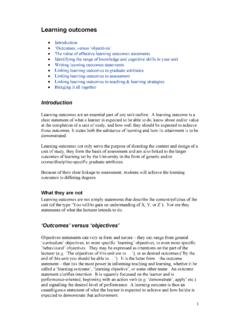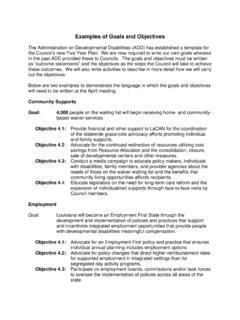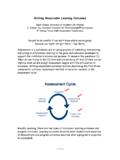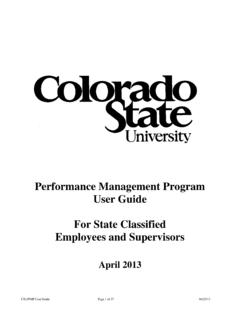Transcription of School Readiness/PFCE Goals-Outcomes
1 Bishop Indian Head Start School Readiness goals and Parent Family Community Engagement April 19th, 2018 SCV Page 1 School Readiness/PFCE Goals-Outcomes (a) Establishing program goals . A program, in collaboration with the governing body and policy council, must establish goals and measurable objectives that include: (3) School readiness goals that are aligned with the Head Start Early Learning Outcomes Framework: Ages Birth to Five, state and tribal early learning standards, as appropriate, and requirements and expectations of schools Head Start children will attend. Achieving program goals . The 2018-2019 School Readiness goals have been received, reviewed, discussed and approved by the Policy Council on: April 27th, 2018 Signed by: Arlene Brown, Policy Chair.
2 The 2018-2019 School Readiness goals have been received, reviewed, discussed and approved by the Bishop Paiute Tribal Council on April 24th, 2018. Signed by: William Vega, Tribal Chairman. Bishop Indian Head Start School Readiness goals and Parent Family Community Engagement April 19th, 2018 SCV Page 2 Table of Content School Readiness Topic Page Overview 3 Table 1: Overview Alignment of the Domains in the California Preschool Learning Foundations with Domains in Key Early Education Resources 4 Group DRDP Measurers Description of Developmental Levels: 5 2016-2017 School Readiness Progress-Fall 2016-Spring 2017 Spring School Readiness Progress 2017 will be available in Early June 2017 6 New 2017-2018 School Readiness goals Spring School Readiness Progress 2018 will be available in Early June 2018 8 Domain.
3 Perceptual, Motor, and Physical Development Measure: PD-HLTH 10: Nutrition 8 Domain: Perceptual, Motor, and Physical Development Measure: PD-HLTH 3: Gross Motor Manipulative Skills 9 Domain: Social and Emotional Development Sub-Domain: Measure: SED 1: Identity of Self in Relation to Others 10 Domain: Social and Emotional Development Measure: SED 2: Social and Emotional Understanding 10 Domain: History and Social Science Measure: Science HSS 4: Conflict Negotiation 11 Domain: Language and Literacy (Language and Communication) Measure: LLD 3: Communication and Use of Language (Expressive) 12 Domain: Language and Literacy (Literacy) Measure: LLD 5: Interest in Literacy 13 Domain: Language and Literacy (Literacy) Measure: LLD 6: Comprehension of Age-Appropriate Text 13 Domain: Approaches to Learning Measure: ATL-REG 4: Curiosity and Initiative in Learning 14 Domain: Cognition (Mathematics Development) Measure: COG 3: Number Sense of Quantity 15 Domain: Cognition (Mathematics Development) Measure: COG 4: Number Sense of Math Operations 16 Domain: Cognition (Mathematics Development) Measure: COG 5: Measurement 16 Domain: Cognition (Scientific Reasoning) Measure: COG 9.
4 Inquiry Through Observation and Investigation 17 Domain: Cognition (Scientific Reasoning) Measure: COG 10: Documentation and Communication of Inquiry 17 Domain: Cognition (Scientific Reasoning) Measure: COG 11: Knowledge of the Natural World 18 Alignment of the Domains in the California Preschool Learning Foundations with Domains in Key Early Education Resources 20 Additional activities related to the BIHS SR/PFCE goals and Objectives 24 References: Bishop Indian Head Start School Readiness goals and Parent Family Community Engagement April 19th, 2018 SCV Page 3 Overview Head Start defines School readiness as children possessing the skills, knowledge, and attitudes necessary for success in School and for later learning in life.
5 The Head Start Approach to School Readiness means that children are ready for School , families are ready to support their children s learning, and schools are ready for children. Historically, Head Start has led the early childhood field with strong, clear, and comprehensive focus on all aspects of healthy development, including social, emotional, cognitive, and physical development, all of which are essential to children getting ready for School . ( ) Bishop Indian Head Start utilizes scientifically research- based assessment tools. Including the following resources: The Early Head Start outcome Framework, The California Preschool Early Learning Foundations, Ages and Stages screening tool, The Devereux Early Childhood Assessment (DECA), Dial 4 a standardized developmental screening tool, Creative Curriculum for preschoolers, and the Desired Results for Children and Families (DRDP).
6 These assessment tools along with teacher and parent observations are used to support children s transition from infant/toddler skills, to preschool and onto kindergarten School readiness skills. Using the data from research-based assessment instruments, Bishop Indian Head Start will advance children s status across the domains of language and literacy development, including children who are dual language learners, the domains of cognition and general knowledge, approaches to learning, social and emotional development and perceptual, motor, and physical development. This holistic approach is based on the needs of children from birth to five years old, to prepare them for their continued growth and development in School readiness skills.
7 Our Lead Teaching team: Teachers and Support Staff, LEAs, Policy Council, Parent Committee, Bishop Paiute Tribal Council, Tribal Social Services, Health Advisory, and our State Preschool partners has supported the School readiness goals and the expansion of updating the goals using aggregated data to continue the advancement of children s skills. The Leadership Team contributes a broad wealth of resources in writing and implementing the School readiness goals for our preschoolers ages 3-5. Bishop Indian Head Start School Readiness goals and Parent Family Community Engagement April 19th, 2018 SCV Page 4 Table 1: Overview Alignment of the Domains in the California Preschool Learning Foundations with Domains in Key Early Education Resources Domains California Preschool Learning Foundations California Infant/Toddler Learning and Development Foundations California Kindergarten Content Standards Common Core State Standards Head Start Child Development and Early Outcomes Learning Framework Ages Birth to 5 Additional Domains in the Head Start Child Development and Early Learning Framework with Corresponding Content Social Emotional Development Social Emotional Development Health Education Mental, Emotional.
8 And Social Health Social & Emotional Development Approaches to Learning Logic & Reasoning Language and Literacy Language Development English Language Arts English Language Arts Language and Literacy Language and Communication Literacy English Language Development Language Development English Language Development English Language Development Literacy Knowledge & Skills Mathematics Cognitive Development Mathematics Mathematics Cognition Mathematics Development Scientific Reasoning Logic & Reasoning Approaches to Learning Visual and Performing Arts All Domains Visual and Performing Arts Creative Arts Expression Logic & Reasoning Physical Development Perceptual and Motor Development Cognitive Development Physical Education Perceptual, Motor and Physical Development Health All Domains Health Education Health, Safety and Nutrition History Social Science Social Emotional Development Cognitive Development History Social Science Social Studies Knowledge & Skills Social & Emotional Development Science Cognitive Development Language Development Science Scientific Reasoning Approaches to Learning Logic & Reasoning Bishop Indian Head Start School Readiness goals and Parent Family Community Engagement April 19th.
9 2018 SCV Page 5 Group DRDP Measurers Description of Developmental Levels: A level is mastered if the child typically demonstrates the behaviors in that level s descriptor. Behaviors are considered typical if the child demonstrates them: Easily and confidently; Consistently over time; In different settings Note: If a child has not mastered the first level of the developmental continuum for a measure, mark the Not yet at first level Exploring: Children at this level show awareness of the feelings and physical differences of self and others; engage in play; use language to describe self, others, events, and stories; enjoy interacting with familiar adults; engage with and respond to literacy activities; recognize symbols, shapes, and patterns; make basic movements with confidence.
10 Cooperate in completing routines; and follow guidance from adults about rules and routines. Developing: Children at this level engage in play and communicate about play with peers; initiate cooperative activities with adults; show increasing knowledge of print; use familiar strategies to solve problems; know some letters and numbers; sort and count small quantities of objects; copy patterns; use movement skills in a variety of settings and tasks; and begin to complete routines and follow rules on their own. Building: Children at this level express their feelings and acknowl-edge the feelings of others; engage in play that is increasingly complex and cooperative; develop close friendships; relate to adults to share experiences and get information; understand and use language to refer to real and imaginary experiences and for social purposes; show increasing understanding of stories and books; write some letters to communicate meaning; use a variety of strategies to learn about objects and solve problems; count, sort, and order objects; use complex movement skills
